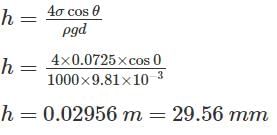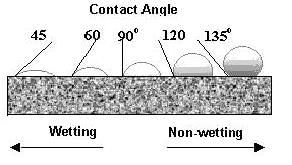Mechanical Engineering Exam > Mechanical Engineering Questions > The capillary rise at 200C in clean glass tub...
Start Learning for Free
The capillary rise at 200C in clean glass tube of 1 mm diameter containing water is approximately
- a)15 mm
- b)50 mm
- c)20 mm
- d)30 mm
Correct answer is option 'D'. Can you explain this answer?
| FREE This question is part of | Download PDF Attempt this Test |
Verified Answer
The capillary rise at 200C in clean glass tube of 1 mm diameter contai...

For water and glass, Contact Angle (θ)=0º and Surface tension is 0.0725 N/m
For mercury and glass, Contact Angle (θ)=128º and Surface tension is 0.52 N/m

Most Upvoted Answer
The capillary rise at 200C in clean glass tube of 1 mm diameter contai...
Capillary Rise in Glass Tube
Capillary rise is the phenomenon of a liquid rising up in a narrow tube due to the cohesive forces between the liquid molecules and the adhesive forces between the liquid and the tube. The height of the liquid rise depends on various factors such as the diameter of the tube, the surface tension of the liquid, the contact angle between the liquid and the tube, and the temperature of the system.
Given Data
Diameter of the tube = 1 mm
Temperature of the system = 20°C
Liquid = Water
Calculation
The capillary rise in a clean glass tube of 1 mm diameter containing water at 20°C can be calculated using the following formula:
h = (2T cosθ)/ρgr
where,
h = height of the rise
T = surface tension of the liquid
θ = contact angle between the liquid and the tube
ρ = density of the liquid
g = acceleration due to gravity
r = radius of the tube
At 20°C, the surface tension of water is 72.8 mN/m and the density of water is 1000 kg/m^3. The contact angle between water and clean glass is approximately 0°. Therefore, the capillary rise can be calculated as:
h = (2 × 72.8 × cos0°)/(1000 × 9.81 × 0.5)
h = 29.5 mm
Therefore, the capillary rise at 20°C in a clean glass tube of 1 mm diameter containing water is approximately 30 mm (option D).
Conclusion
The capillary rise in a clean glass tube of 1 mm diameter containing water at 20°C can be calculated using the formula h = (2T cosθ)/ρgr. The capillary rise is approximately 30 mm.
Capillary rise is the phenomenon of a liquid rising up in a narrow tube due to the cohesive forces between the liquid molecules and the adhesive forces between the liquid and the tube. The height of the liquid rise depends on various factors such as the diameter of the tube, the surface tension of the liquid, the contact angle between the liquid and the tube, and the temperature of the system.
Given Data
Diameter of the tube = 1 mm
Temperature of the system = 20°C
Liquid = Water
Calculation
The capillary rise in a clean glass tube of 1 mm diameter containing water at 20°C can be calculated using the following formula:
h = (2T cosθ)/ρgr
where,
h = height of the rise
T = surface tension of the liquid
θ = contact angle between the liquid and the tube
ρ = density of the liquid
g = acceleration due to gravity
r = radius of the tube
At 20°C, the surface tension of water is 72.8 mN/m and the density of water is 1000 kg/m^3. The contact angle between water and clean glass is approximately 0°. Therefore, the capillary rise can be calculated as:
h = (2 × 72.8 × cos0°)/(1000 × 9.81 × 0.5)
h = 29.5 mm
Therefore, the capillary rise at 20°C in a clean glass tube of 1 mm diameter containing water is approximately 30 mm (option D).
Conclusion
The capillary rise in a clean glass tube of 1 mm diameter containing water at 20°C can be calculated using the formula h = (2T cosθ)/ρgr. The capillary rise is approximately 30 mm.
Free Test
FREE
| Start Free Test |
Community Answer
The capillary rise at 200C in clean glass tube of 1 mm diameter contai...
For water and glass combination theta= 0 degree and surface tension= 0.0725 so H= (4 x surface tension x cos theta)/ (density x g x D) H = (4x.0725xcos0)÷(1000x9.81x0.001) H= 0.029m H= 30 mm option D is correct.
Attention Mechanical Engineering Students!
To make sure you are not studying endlessly, EduRev has designed Mechanical Engineering study material, with Structured Courses, Videos, & Test Series. Plus get personalized analysis, doubt solving and improvement plans to achieve a great score in Mechanical Engineering.

|
Explore Courses for Mechanical Engineering exam
|

|
Similar Mechanical Engineering Doubts
The capillary rise at 200C in clean glass tube of 1 mm diameter containing water is approximatelya)15 mmb)50 mmc)20 mmd)30 mmCorrect answer is option 'D'. Can you explain this answer?
Question Description
The capillary rise at 200C in clean glass tube of 1 mm diameter containing water is approximatelya)15 mmb)50 mmc)20 mmd)30 mmCorrect answer is option 'D'. Can you explain this answer? for Mechanical Engineering 2024 is part of Mechanical Engineering preparation. The Question and answers have been prepared according to the Mechanical Engineering exam syllabus. Information about The capillary rise at 200C in clean glass tube of 1 mm diameter containing water is approximatelya)15 mmb)50 mmc)20 mmd)30 mmCorrect answer is option 'D'. Can you explain this answer? covers all topics & solutions for Mechanical Engineering 2024 Exam. Find important definitions, questions, meanings, examples, exercises and tests below for The capillary rise at 200C in clean glass tube of 1 mm diameter containing water is approximatelya)15 mmb)50 mmc)20 mmd)30 mmCorrect answer is option 'D'. Can you explain this answer?.
The capillary rise at 200C in clean glass tube of 1 mm diameter containing water is approximatelya)15 mmb)50 mmc)20 mmd)30 mmCorrect answer is option 'D'. Can you explain this answer? for Mechanical Engineering 2024 is part of Mechanical Engineering preparation. The Question and answers have been prepared according to the Mechanical Engineering exam syllabus. Information about The capillary rise at 200C in clean glass tube of 1 mm diameter containing water is approximatelya)15 mmb)50 mmc)20 mmd)30 mmCorrect answer is option 'D'. Can you explain this answer? covers all topics & solutions for Mechanical Engineering 2024 Exam. Find important definitions, questions, meanings, examples, exercises and tests below for The capillary rise at 200C in clean glass tube of 1 mm diameter containing water is approximatelya)15 mmb)50 mmc)20 mmd)30 mmCorrect answer is option 'D'. Can you explain this answer?.
Solutions for The capillary rise at 200C in clean glass tube of 1 mm diameter containing water is approximatelya)15 mmb)50 mmc)20 mmd)30 mmCorrect answer is option 'D'. Can you explain this answer? in English & in Hindi are available as part of our courses for Mechanical Engineering.
Download more important topics, notes, lectures and mock test series for Mechanical Engineering Exam by signing up for free.
Here you can find the meaning of The capillary rise at 200C in clean glass tube of 1 mm diameter containing water is approximatelya)15 mmb)50 mmc)20 mmd)30 mmCorrect answer is option 'D'. Can you explain this answer? defined & explained in the simplest way possible. Besides giving the explanation of
The capillary rise at 200C in clean glass tube of 1 mm diameter containing water is approximatelya)15 mmb)50 mmc)20 mmd)30 mmCorrect answer is option 'D'. Can you explain this answer?, a detailed solution for The capillary rise at 200C in clean glass tube of 1 mm diameter containing water is approximatelya)15 mmb)50 mmc)20 mmd)30 mmCorrect answer is option 'D'. Can you explain this answer? has been provided alongside types of The capillary rise at 200C in clean glass tube of 1 mm diameter containing water is approximatelya)15 mmb)50 mmc)20 mmd)30 mmCorrect answer is option 'D'. Can you explain this answer? theory, EduRev gives you an
ample number of questions to practice The capillary rise at 200C in clean glass tube of 1 mm diameter containing water is approximatelya)15 mmb)50 mmc)20 mmd)30 mmCorrect answer is option 'D'. Can you explain this answer? tests, examples and also practice Mechanical Engineering tests.

|
Explore Courses for Mechanical Engineering exam
|

|
Suggested Free Tests
Signup for Free!
Signup to see your scores go up within 7 days! Learn & Practice with 1000+ FREE Notes, Videos & Tests.
























